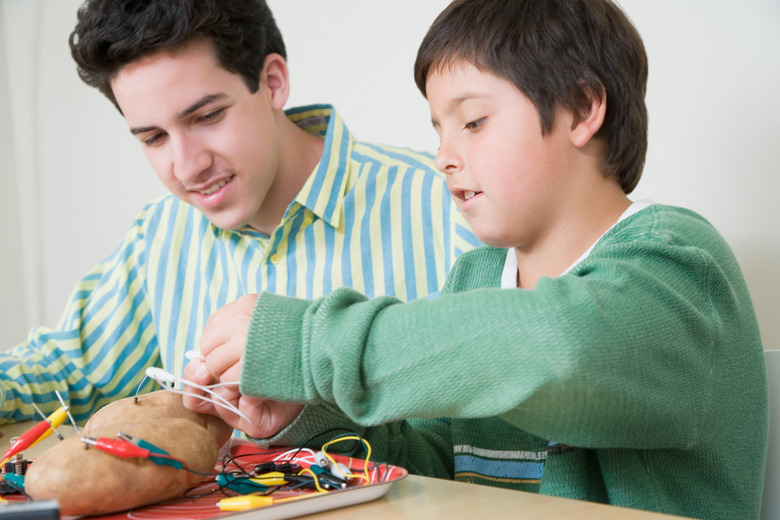How Can You Make A Potato Flashlight Project?
A potato flashlight project is a great experiment to make with your kids to keep them entertained for a while. Ask them if they think you can make a flashlight bulb illuminate using a potato; chances are they'll look at you blankly. Making a potato flashlight project introduces kids to rudimentary electric circuits and is undoubtedly something they will learn from and also remember. Additionally, you probably have everything you need to complete the project in your home or garage.
Step 1
Draw a rough sketch of the project on a sheet of paper using a pen, so your kids can visualize how to make a potato flashlight. Draw the shape of a potato then draw two straight lines that are half inside the drawing of the potato and half protruding outside. Use a red pen for one line and a gray pen for the other.
Step 2
Draw a light bulb about two inches above the drawing of the potato. Draw two lines extending from the light bulb; join one line up to the top of the straight red line and the other up to the top of the straight gray line that you drew earlier that extend from the potato. These two lines represent wires connecting the flashlight bulb, effectively to a battery.
Step 3
Put the potato on the work surface. Put the copper nail into the potato, about one inch from the center, ensuring the end protrudes about two inches. Put the zinc or galvanised nail into the potato two inches away from the other nail, but make sure two inches of it protrude from the potato.
Step 4
Cut two strips of wire using a knife. Each strip should be about four inches. Strip off about 1/4 inch of plastic coating from one end of each wire using wire strippers. Strip off 3/4 inch of plastic of the opposite ends.
Step 5
Wind the 3/4 inch of bare wire around the tops of each nail using your fingers. Wrap a small strip of adhesive tape over the wire and nail so it holds the wire in place.
Step 6
Attach the opposite end of one of the wires to one of the terminals on the potato flashlight; it doesn't matter which one. Use a strip of tape to hold it in place. Attach the end of the other wire to the remaining terminal on the flashlight using tape. The flashlight should illuminate, although it may not be very bright.
Step 7
Explain the basis of the project and why the flashlight illuminates. The two nails are made of different metals. When they are inserted into the potato, a chemical reaction takes place. The acids, starch and sugar react with the metals and cause a small electric current to flow inside the potato. The electricity is tapped by connecting a flashlight to the two nails, which are effectively electrodes; one is positive and the other is negative. When you connect the flashlight, a circuit is formed, so the electricity can flow and light the bulb.
Things Needed
- Paper
- Colored pens
- Large potato
- 4 inch copper nail
- 4 inch zinc (or galvanized) nail
- Strip of thin wire.
- Knife
- Wire strippers
- Adhesive tape
- 1.5-volt flashlight bulb
Cite This Article
MLA
Stevens, James. "How Can You Make A Potato Flashlight Project?" sciencing.com, https://www.sciencing.com/can-make-potato-flashlight-project-8784333/. 24 April 2017.
APA
Stevens, James. (2017, April 24). How Can You Make A Potato Flashlight Project?. sciencing.com. Retrieved from https://www.sciencing.com/can-make-potato-flashlight-project-8784333/
Chicago
Stevens, James. How Can You Make A Potato Flashlight Project? last modified March 24, 2022. https://www.sciencing.com/can-make-potato-flashlight-project-8784333/
